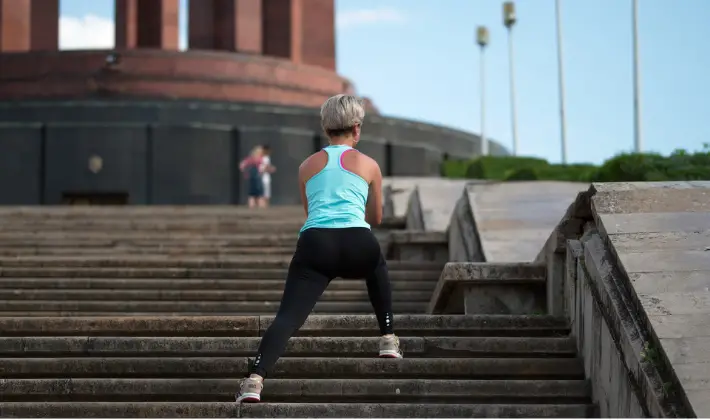Stairs Running Workout: Benefits And Disadvantages

One of the keys to successful marathon (or half marathon) training is to vary your workouts. Variation can be built in with the type/variety of runs that you do (easy, tempo, pace, intervals, etc), strength/ weight training (both upper body and lower body strength workouts) as well as cross training (cycling, swimming, etc).
Unfortunately, building all these into the day while managing your other life demands is quite challenging for most of us.
In this article, we will cover how stair climbing workouts can be incorporated into your training schedule and offer a multitude of benefits like aerobic conditioning, lower body strength, etc with just 20-30 minutes of your time, a couple of times a week.
Benefits of Running On Stairs
Why you should incorporate stair climbing into your training
1. Vertical Movement: Walking and running involves moving your body in a horizontal pattern though with running you do experience slight vertical movement. However, with stair climbing, your muscles are forced to resist gravity and move in a vertical pattern putting additional demand on your lower body muscles. This helps build two essential needs of any runner – Strength and Power
2. Readily Available: Stairs are generally readily available in apartments, office buildings, on streets and in public areas. And harsh weather conditions (like snow, rain, etc) are not an issue for indoor staircases and hence can be incorporated at any point throughout the day .
3. More intense: When you climb stairs, you burn more calories than running or walking (over the same duration of time). It also provides high-intensity cardio workout to test your lungs and heart which can give a boost to your aerobic capacity. It can even be more strenuous than running hill repeats since most stairs are significantly steeper than the average hill/ flyover
4. Strengthens Glutes and Quads: The plyometric motion strengthens your muscles, heart and lungs for better running and forces you to utilize muscle stabilizers, like the glutes, that get neglected during regular runs.
5. Low frequency and short duration: Plyometric exercises like stair climbing are great because you do not need to do them too frequently or for a long duration. Incorporating a 10-15 minute session 2-3 times a week is also beneficial.
Disadvantages of Climbing Stairs Exercise
Although stairs climbing is a great cardio exercise, it might not be a suitable exercise for everyone.
1. Offers only lower body workout: Stair climbing can work your leg muscles, but it doesn’t address other muscle groups in your body unless you build in some variations involving upper body workout.
2. Exacerbate existing issues: Climbing stairs might cause further injury for people with existing problems in their bones or soft tissues of their knees.
3. Shortening of stride: One potential drawback of stairs is that your stride might possibly be shortened if you try to adjust to shorter step distances. This can be problematic if you include stairs into your marathon training too often. Quicker strides help runners get faster, so you should try to run up the stairs with quick leg turnover while doing stair climbing. Also, incorporate lunges or “bounding” strides into your regime and try to skip every other or every third stair if you can (do so safely).
How to Build Stairs Climbing into your Daily Routine?
There are a multitude of ways you can add stair climbing to your daily routine or as a variation to your workout. If you are a runner, do remember, that stair climbing is usually not considered a ‘cross-training’ workout (like swimming or cycling) but rather a plyometric workout which is an add-on to your running programme.
1. Ditch the elevator: You do not need to stick to a dedicated stair climbing workout to reap its benefits. Given a choice, take the stairs wherever and whenever you can. Avoiding the elevator at work/ at the mall/ home adds up and it can go a long way to adding much needed exercise to your daily routine.
2. Start easy: As with running, it would bode well for your body to start easy. Which means for the initial few days, walk up the stairs and then walk back down. Rest for a few seconds (if required) and repeat. The number of repeats will be dependent on the number of stairs/ stair length as well as your fitness level. You should aim at slowing building in more repeats.
3. Speed up: Once you have built basic stamina for stair climbing, you can move up to jogging or running up the stairs and walking back down. With practise, you can also set a time frame – e.g. 10 / 15 minutes and try and do as many repeats as possible within that time period. Try to beat your record each time you repeat the workout.
4. Go heavy: Strap on a backpack with few weights stacked inside or a weighted vest to increase the intensity of your workout. I would not recommend wearing ankle weights as it might alter your gait or cause imbalance. As with initial build up, please start with lighter weights before moving on to heavier load. Also take extra care while descending the stairs (with weights).
5. Make it a full body workout: Add a few squats/ burpees/ sit ups/ push-ups, etc on each landing as you ascend or/and descend stairs. You can even climb the stairs with a dumbbell or kettlebell (in each hand, for balance) and do a set of strength training exercises (on each landing). E.g. kettlebell swings, dumbbell curl, sumo squats and stationary lunges. Another alternative is to take a jump rope with you and do a few rope turns at each landing. Increase the rope turns or make them double unders to increase the intensity.
6. Double it!: You can climb two stairs (double step) at a time to increase intensity but be mindful that double step is a more strenuous workout involving longer strides, so if you have a poor balance or suffer from knee issues or have short legs, it can increase injury risk
7. Ladder it up: Similar to ladder intervals, it increases duration of stair climbing with each set. So you walk/ jog/ run up to the first landing and then back down. Then, without pausing, walk/jog/run up to the second landing (so, climb a total of 2 landings) and back down. Turn around and then run up to the third landing (so, climb a total of 3 landings) and back down. Keep increasing one landing at a time.
8. Do it sideways: Instead of walking or running forward up the stairs, try walking sideways (with your feet parallel to the stairs). For e.g. if your right foot is parallel and closest to the stair, bend your knees and hips slightly and put your right foot on the first step followed by your left foot. Repeat this motion till you reach the first landing. Walk down the stairs normally. Changing the direction of stair climbing will work a different set of muscles. Practice caution, keep it steady and do not rush. Pick up speed when you feel comfortable.
9. Bear crawl / Stair crawl: Bear-crawl up the stairs to get your upper body in on the action. A bear crawl is performed with your belly facing the floor and traveling head first by moving your opposite arm and leg forward, at the same time, to the next step
10. Crab walk: A crab crawl is performed with your belly facing the ceiling and traveling feet first with the arms behind your body. Hence this exercise starts at the top of the stairs instead of at the bottom.
Precautions for Stairs Running
1. Type of staircase: Find stairs that are long (number of steps), straight and wide for the workout. Narrow or spiral staircases are not ideal and are troublesome to navigate for a workout.
2. Check with your doctor: Stair climbing is a strenuous form of exercise so check with your healthcare professional before starting a new workout routine.
3. Start easy: Start off slow and easy. Increase the periodicity, intensity, variety and duration of your workouts gradually. Pay attention to any pain or discomfort that you might experience in your knees, ankles, hips or back.
4. Apply and practice the same basics as other exercises: Start by warming up and cool down with stretching. Practise good form to reduce injury. Hydrate while exercising
5. Don’t just use your calf muscles and avoid stepping just on your toes: With each step you take, make sure you lift your leg high, put your entire foot on the step and push off with your heel (will help reduce strain on the knees). Focus on using your larger leg muscles.
6. Walk down the stairs: It is safest to descend walking down the stairs (not running) using each step as it stresses the knees and ankles.





